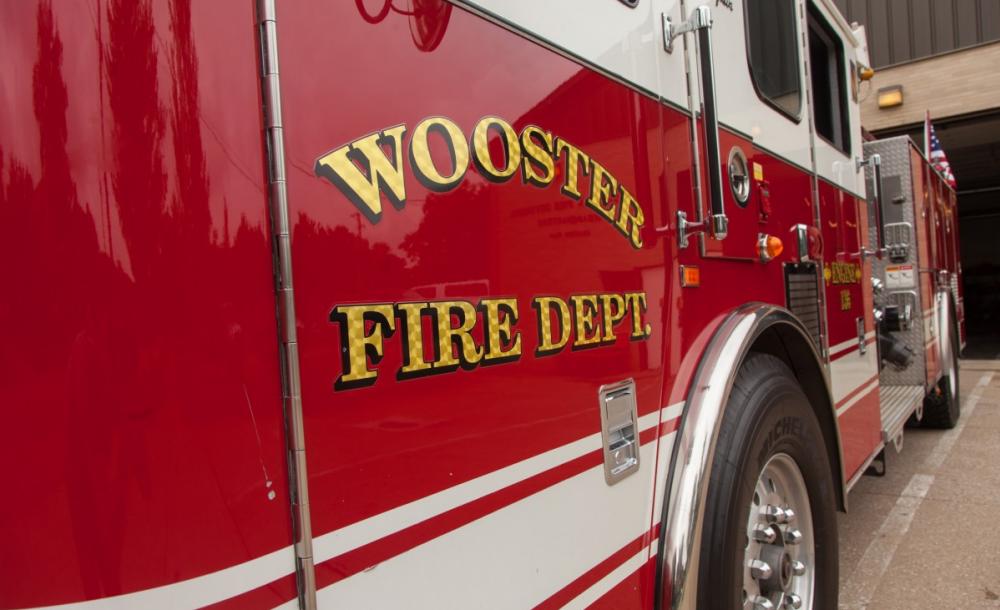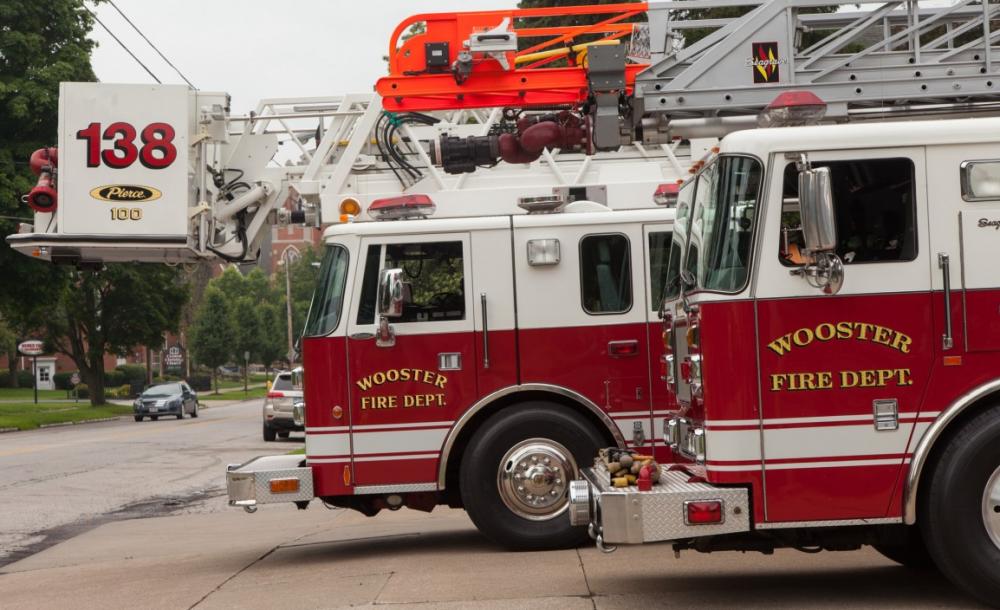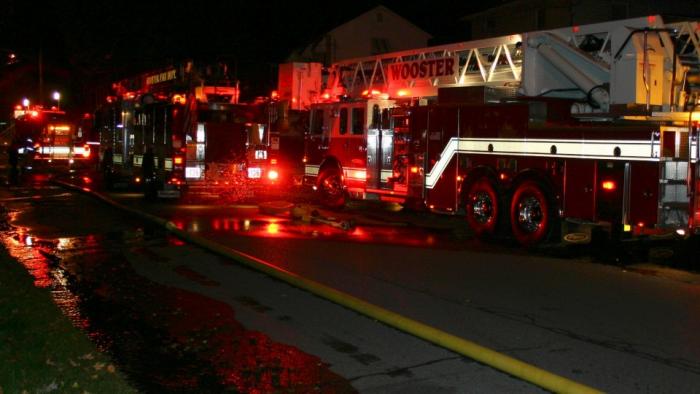

The Fire Department doesn't actually collect the cans, Wooster Fire Fighters Local 764, the fire fighters local union, collects them for ACBC (Aluminum Cans for Burned Children). The drop off point is a large red container in the parking lot between Fire Station 1 and City Hall on Liberty Street in Wooster, and at Buehlers Fresh Foods Wooster Milltown, to the rear of the building near the recycling bins. Click the links below for more information about the ACBC programs we donate to.
Currently within the City limits there are 3 Fire Stations, Station 1 at 510 N. Market Street, Wooster Safety Center (Fire Station #2) at 3333 Burbank Road, and Station 3 at 2255 Gateway Drive.
The administrative offices for the Fire Dept. are located at the Safety Center, Station 2, and the phone number is 330-263-5266.
The Wooster Fire Division operates with a minimum staffing of 10 citywide 24/7. Station 2 and 3, operate with 2 firefighters and 1 Lieutenant per station, with Station 1 also having a Battalion Captain. Medic vehicles are staffed with a at least 3 personnel, with a minimum of 2 paramedics. All personnel work a 24 hour shift.
Many times an Engine is closer to an emergency scene and is dispatched along with a Medic vehicle. In this case the Engine is called a "First Responder" since it is expected to arrive first on the scene and render emergency care as quickly as possible. After the Medic transport vehicle arrives, the members of the engine company will assist those paramedics. With this technology and progressive management system, the citizens of Wooster are provided with both rapid response and quality care at a time when they are most in need.
The Medic company is responsible for treating the sick and injured at the scene of a fire or other emergency. The medic carries Advance Cardiac Life Support equipment, (ACLS), AED, IV solutions, oxygen, and cardiac drugs. The medic also is equipped with, vacuum splints, backboards, suction devices, and other equipment and drugs that can be used for all types of medical emergencies.
The job assigned to an Engine Company is determined by the type of building involved in the fire and the arrival sequence of the truck. For this discussion, we will consider a report of a house fire. This type of assignment would include two engines/ladder truck, one medic, and one battalion chief. In this situation the Wooster Fire engine companies on a fire scene are primarily responsible for rescue, extinguishment and water supply.
The first engine company to arrive on the scene of a working fire is charged with rescue of fire victims, then with extinguishment. Wooster Fire Division policy is for a quick interior attack on the fire whenever possible. This includes making quick entry to the fire building to find and extinguish the source or seat of the fire. Throwing water at smoke from outside a window will not put out the fire. Of course every fire is different, there is no such thing as a normal fire. Initial fire line placement, method and location of the entry point, and fire line size are just a few of the variables that must be considered on every scene.
The second engine company to arrive on the scene of a working fire is charged with water supply to the first engine and then backup for the first crew in the building. These two jobs are usually taken care of at the same time by different members of the crew on the second engine. The "usual" procedure for the second engine company is to stop at a hydrant closest to the fire and lay a 4 inch diameter supply line on the way to the fire building. This size supply line should be large enough to supply the first truck with water to spare. Once the second engine is at the fire building part of the crew will complete the hook up of the supply line to the first engine, while the rest of the crew will take an additional line off the first truck to back-up the crew off the first engine.
The inside crew will do a quick search of all areas which can be entered. As they search, they will ventilate the building as they go opening windows to remove the smoke. They are also available to open up the walls, ceiling, and floors to look for fire which may be burning out of sight.
The outside crew will assist in rescue operations by placing ladders at secondary exit points to provide a means of escape for occupants of the building or firefighters. The outside crew will also assist in ventilating the building from the outside. This usually includes breaking the windows in the fire room from the outside. This ventilation will remove some of the heat from the fire area allowing engine companies to get close enough to extinguish the seat of the fire. The exterior crew may also be asked to vent the roof to relieve the built up heat making it possible for entry to the fire area.
The Engine companies are responsible for fire suppression, so on the engine they carry the water and hoses. Most Wooster Fire engines have at least a 500-gallon water tank. Each engine also carries a 1,000’ of 4" hose, which can be connected to a hydrant and used to supply water from the hydrant to the engine once the Engine’s 500 gallons has diminished. The engine, also known as a pumper, has a pump on it, which can pump over 1,500 gallons a minute. Also on the engine there are several hand lines which can be taken inside the building. The standard hand line is 200’ in length and is 1 3/4" in diameter. In comparison, a garden hose is approximately ¾ inch in diameter.
The engine and any ladder companies carry equipment that will assist with ventilation, forcible entry, search and rescue, and overhaul. Ventilation is important because it allows the super-heated toxic gases to escape and also allows the firefighters inside to do their work more efficiently. All ladder trucks carry chainsaws and circular saws. These saws are used to cut holes into roofs and walls. To be able to get into a building you need the right kind of tools therefore ladder companies carry many different types of tools. A couple examples are the hydraulic rabbit tool, which pulls a door away from the jam. For search and rescue the technology is now available to have hand held thermal-imaging cameras. These cameras allow firefighters to see through the smoke and see the victims. Our department has one on each of our rescue and ladder companies. Overhaul is basically cleaning up. Removing all the debris that was destroyed in the fire and make sure all hot spots are extinguished.
As a fire burns, it generally moves upward, then outward. Removing windows and cutting holes in the roof, or "ventilation" in firefighting terms, stops that damaging outward movement and enables them to fight more efficiently, resulting in less damage.
The Fire Department has to be sure, absolutely sure, that ALL the fire is out and that there are no hidden fires inside the ceilings, walls or partitions.
If the fire was of such magnitude that you cannot continue to reside in the home, and assistance is needed, tell the Battalion Chief or investigating Fire Inspector as soon as possible. They will be able to contact the proper authorities for you. The local American Red Cross Chapter is prepared to offer immediate and temporary assistance which may include housing, food and clothing.
Refer to "The fire is out, now what?" FAQ for more information.
The Wooster Division of Fire has "mutual aid" agreements that are beneficial to surrounding townships and municipalities. This type of agreement can both protect a larger area and provide a larger number of firefighters and equipment at the scene of a major incident.
A day at the firehouse consists of a 24 hour tour of duty, which begins at 0700 roll call. Generally, a firefighter must remain with his/her crew the entire tour and "live" at the firehouse. All firefighters will check their vehicles for readiness after roll call. Then the crew will have coffee and decide upon the meals for the day. The Engine driver then goes to the supermarket and buys enough groceries for the crew for that day.
Firefighters are permitted 1 hour each day for physical fitness training. Many choose to engage in weightlifting or aerobic exercises. You might see a friendly game of basketball behind the fire house. Whichever manner is chosen, the objective is the same: to remain physically fit to endure the rigors of the job.
The entire crew works together to keep the firehouse clean and the apparatus in good working condition. There are other duties such as fire prevention inspections, hose tests, and in-service training.
Firefighters spend some time every shift training in some way. This may consist of EMS or Fire training. There are structured training sessions covering the vast scope of knowledge which firefighters must keep up to date. Subjects include: Hazardous Materials, Building Construction, Electrical Emergencies, River Rescue, Basic Trauma Life Support, Confined Space Rescue, Hose Lays, Ladder Evolutions, Pump Operations, Communications, etc.
While all these routine duties are being accomplished, firefighters must be prepared to drop everything and respond at a moment's notice to a wide variety of emergency situations. A typical day might include a few fire alarms, a couple auto accidents, several medical emergencies, and a house fire. After 10pm, the firefighters are permitted to lie down and catch a series of "cat naps" between emergency runs over the course of the night.
We would be happy to give anyone a tour, but we request that you call several days in advance, just to make sure the time you wish to schedule is available and not filled because of training, continuing education, equipment repairs, etc.
We block traffic lanes for the safety of our personnel and our patients. Blocking extra lanes keep our personnel safe when they return to our apparatus to get more equipment. It also helps to protect the victim we are trying to stabilize. Over 25 firefighters are killed or injured each year while working at incidents on streets and highways.
Firefighters are very concerned about running over fire hoses because the hose can be damaged and any firefighter at the end of a nozzle will have the water interrupted and possibly cause injuries or death. Any hose that is driven over without protection has to be taken out of service and tested and replaced or repaired if needed.
Snow, weeds and bushes should be kept three feet from fire hydrants for visibility and accessibility by Fire Department personnel.
The Fire Department does not assist in rescuing animals. Citizens may contact the Humane Society for assistance. The telephone number is (330) 262-0152.
Currently, the Wooster Fire Department is unable to install car safety seats. The Ohio State Highway Patrol at 1786 Dover Rd, Wooster will assist you in installing your seat. Phone: (330) 264-0575
Fire Prevention Bureau
Phone: (330) 263-5266
Fax: (330) 263-5281

